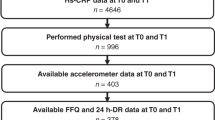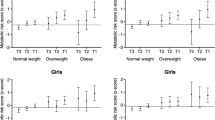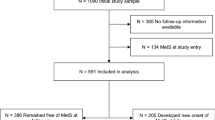Abstract
OBJECTIVES:
This paper aim to review the newest literature linking physical inactivity and low fitness to metabolic disorders including cardiovascular disease (CVD) risk factors and obesity.
METHODS:
There is a rationale for early prevention of CVD if (a) children have a risk factor profile, where risk for future disease is increased, (b) physical activity and CVD risk factors track into adulthood, and (c) increased physical activity can improve the risk factor profile. We reviewed the evidence for a progressive evolution of atherosclerosis starting in childhood, and also that physical activity decreases the rate of the process through several mechanisms. Among the central mechanisms mediating the effect of physical activity are (a) increased insulin sensitivity, (b) a non-insulin-dependent glucose uptake, which causes lower insulin release, (c) an improved ratio between HDL and LDL cholesterol because of increased activity of lipoprotein lipase, and d) improved function of other metabolic hormones and enzymes for fat metabolism.
RESULTS:
The association between CVD risk factors and physical activity/fitness is weak, when risk factors are analysed isolated. In the normal healthy population of children, studies have shown that risk factors cluster and this clustering is strongly related to low physical activity or fitness. In European children it has been found that as many as 15% of 9-y-old children has clustered risk. Most of the overweight and obese children are among these, but many of the children are lean inactive children, who may later become overweight because of insulin resistance.
CONCLUSION:
It can be concluded that there is a large potential for primary prevention of CVD in European children, and lifestyle changes including increased physical activity as one of the key actions should be initiated.
This is a preview of subscription content, access via your institution
Access options
Subscribe to this journal
Receive 12 print issues and online access
$259.00 per year
only $21.58 per issue
Buy this article
- Purchase on Springer Link
- Instant access to full article PDF
Prices may be subject to local taxes which are calculated during checkout
Similar content being viewed by others
References
Vuori I, Fentem P, Andersen LB, Felten RW, Rubana M, Strömme SB, Haulicá J, Ekblom B . The significance of sport for society. Council of Europe Press: Strasbourg; 1995. pp 19–87.
Andersen LB, Henckel P, Saltin B . Risk factors for cardiovascular disease in 16–19-year-old teenagers. J Int Med 1989; 225: 157–163.
Andersen LB . Blood pressure, physical fitness and physical activity in 17-year-old Danish adolescents. J Int Med 1994; 236: 323–330.
Nielsen GA, Andersen LB . The association between high blood pressure, physical fitness, and body mass index. Prev Med 2003; 36: 229–234.
Armstrong N, Simons-Morton B . Physical activity and blood lipids in adolescents. Pediatr Exerc Sci 1994; 6: 381–405.
Katzmarzyk PT, Malina RM, Bouchard C . Physical activity, physical fitness, and coronary heart disease risk factors in youth: the Québec Family Study. Prev Med 1999; 29: 555–562.
Stewart KJ, Brown CS, Hickey CM, McFarland LD, Weinhofer JJ, Gottlieb SH . Physical fitness, physical activity, and fatness in relation to blood pressure and lipids in preadolescent children. Results from the FRESH Study. J Cardiopulm Rehabil 1995; 15: 122–129.
Ku CY, Gower BA, Hunter CR, Goran MI . Racial differences in insulin secretion and sensitivity in prepubertal children: role of physical fitness and physical activity. Obes Res 2000; 8: 506–515.
Al-Hazzaa HM, Sulaiman MA, Al-Matar AJ, Al-Mobaireek KF . Cardiorespiratory fitness, physical activity patterns and coronary risk factors in preadolescent boys. Int J Sports Med 1994; 15: 267–272.
de Visser DC, Van Hooft IM, Van Doornen LJ, Hofman A, Orlebeke JF, Grobbee DE . Anthropometric measures, fitness and habitual physical activity in offspring of hypertensive parents: Dutch hypertension and offspring study. Am J Hypertens 1994; 7: 242–248.
Dwyer T, Gibbons LE . The Australian schools health and fitness survey: physical fitness related to blood pressure but not lipoproteins. Circulation 1994; 89: 1539–1544.
Harrell JS, McMurray RG, Gansky SA, Bangdiwala SI, Bradley CB . A public health vs a risk-based intervention to improve cardiovascular health in elementary school children: the cardiovascular health in children study. Am J Public Health 1996; 89: 1529–1535.
Webber LS, Osganian SK, Feldman HA, Wu M, McKenzie TL, Nichaman MZ, Lytle LA, Edmundson E, Cuttler J, Nader PR, Luepker RV . Cardiovascular risk factors among children after 21/2-year intervention - the CATCH Study. Prev Med 1996; 25: 432–441.
Suter E, Hawes MR . Relationship of physical activity, body fat, diet, and blood lipid profile in youths 10–15 yr. Med Sci Sports Exerc 1992; 25: 748–754.
Bistritzer T, Rosenzweig L, Barr J, Mayer S, Schlesinger Z, Aladjem M . Lipid profile with paternal history of cardiovascular disease before age 40. Arch Dis Childhood 1995; 73: 62–65.
Craig SB, Bandini LG, Lichtenstein AH, Schaefer EJ, Dietz WH . The impact of physical activity on lipids, lipoproteins and blood pressure in preadolescent girls. Pediatrics 1996; 98: 389–395.
Gutin B, Cucuzzo N, Islam S, Smith C, Stachura ME . Physical training, lifestyle education and coronary risk factors in obese girls. Med Sci Sports Exerc 1996; 28: 19–23.
Twisk JWR, Kemper HCG, Mellenbergh GJ, Mechelen Wv, Post GB . Relationship between the longitudinal development of lipoprotein levels and lifestyle parameters during adolescence and young adulthood. Ann Epidemiol 1996; 6: 246–256.
Boreham C, Twisk JWR, Savage MJ, Cran GW, Strain JJ . Physical activity, sports participation, and risk factors in adolescents. Med Sci Sports Exerc 1997; 29: 788–793.
Jenner DA, Vandongen R, Beilin LJ . Relationships between blood pressure and measures of dietary energy intake, physical fitness, and physical activity in Australian children aged 11–12 years. J Epidemiol Comm Health 1992; 46: 108–113.
Harrell JS, McMurray RG, Bangdiwala SI, Frauman AC, Gansky SA, Bradley CB . Effects of a school-based intervention to reduce cardiovascular disease risk factors in elementary-school children: the Cardiovascular Health in Children (CHIC) Study. J Pediatr 1996; 128: 797–805.
Shear CL, Freedman DS, Burke GL, Harsha DW, Berenson GS . Body fat patterning and blood pressure in children and young adults. The Bogalusa Heart Study. Hypertension 1987; 9: 236–244.
Stallones L, Mueller WH, Christensen BL . Blood pressure, fatness, and fat patterning among USA adolescents from two ethnic groups. Hypertension 1982; 4: 483–486.
Andersen LB . Relative risk of mortality in the physically inactive is underestimated because of real changes in exposure level during follow-up. Am J Epidemiol 2004; 160: 189–195.
Riddoch C, Andersen LB, Wedderkopp N, Harro M, Heggebø LK, Sardinha LB, Cooper A, Ekelund U . Physical activity levels and patterns of 9 and 15 year old European children. Med Sci Sports Exerc 2004; 36: 86–92.
Daniels SR, Morrison JA, Sprecher DL, Khoury P, Kimball TR . Association of body fat distribution and cardiovascular risk factors in children and adolescents. Circulation 1999; 99: 541–545.
Gillum RF . Distribution of waist to hip ratio, other indices of body fat distribution and obesity and associations with HDL cholesterol in children and young adults aged 4–19 years: the Third National Health and Nutrition examination Survey. Int J Obes Relat Metab Disord 1999; 23: 556–563.
Folsom AR, Caspersen CJ, Taylor HL, Jacobs DR, Luepker RV, Gomez-Marin O, Gillum RF, Blackburn H . Leisure time physical activity and its relationship to coronary risk factors in a population-based sample. The Minesota Heart Survey. Am J Epidemiol 1985; 121: 570–579.
Lenthe FJv, Mechelen Wv, Kemper HCG, Twisk JWR . Association of a central pattern of body fat with blood pressure and lipoproteins from adolescence into adulthood. The Amsterdam Growth and health study. Am J Epidemiol 1998; 147: 686–693.
Andersen LB, Wedderkopp N, Riddoch C, Froberg K, Hansen HS . Biological cardiovascular risk factors cluster in Danish children and adolescents. Danish part of the European Heart Study. Prev Med 2003; 37: 363–367.
Wedderkopp N, Froberg K, Nansen HS, Riddoch C, Andersen LB . Cardiovascular risk factors cluster in children and adolescents with low physical fitness. Pediatr Exerc Sci 2003; 15: 419–422.
Andersen LB, Hasselstrøm H, Grønfeldt V, Hansen SE, Froberg K . The relationship between physical fitness and clustered risk, and tracking of clustered risk from adolescence to young adulthood: eight years follow-up in the Danish Youth and Sport Study. Int J Behav Nutr Phys Fitness 2004; 1: 6.
Bergström E, Hernell O, Persson Lring, Vessby B . Insulin resistance syndrome in adolescents. Metabolism 1996; 45: 908–914.
US Department of Health and Human Services. Physical activity and health: a report of the Surgeon General. U.S. Department of Health and Human Services. Centers for Disease Control and Prevention, National Center for Chronic Disease Prevention and Health Promotion: Atlanta; 1997.
Twisk JWR, Kemper HCG, Mellenbergh GJ . Mathematical and analytical aspects of tracking. Epidemiol Rev 1994; 16: 165–183.
Andersen LB . Tracking of risk factors for coronary heart disease from adolescence to young adulthood with special emphasis on physical activity and fitness. Dan Med Bull 1996; 43: 407–418.
Andersen LB, Haraldsdóttir J . Tracking of cardiovascular disease risk factors including maximal oxygen uptake and physical activity from late teenage to adulthood. An 8-year follow-up study. J Int Med 1993; 234: 309–315.
Andersen LB, Haraldsdottir J . Changes in physical activity, maximal isometric strength and maximal oxygen uptake from late teenage to adulthood. An 8-year follow-up study of adolescents in Denmark. Scand J Med Sci Sports 1994; 4: 19–25.
Janz KF, Dawson JD, Mahoney LT . Tracking physical fitness and physical activity from childhood to adolescence: the Muscatine Study. Med Sci Sports Exerc 2000; 32: 1250–1257.
Kelder SH, Perry CL, Klepp K-I, Lytle LL . Longitudinal tracking of adolescents smoking, physical activity, and food choice behaviors. Am J Public Health 1994; 84: 1121–1126.
Malina RM . Tracking of physical activity and physical fitness across the lifespan. Res Q Exerc Sport 1996; 67: s-48–s-57.
Twisk JWR, Kemper HCG, van Mechelen W . Tracking of activity and fitness and the relationship with cardiovascular disease risk factors. Med Sci Sports and Exerc 2000; 32: 1455–1461.
Powell KE, Dysinger W . Childhood participation in organized school sports and physical education as precursors of adult physical activity. Am J Prev Med 1987; 3: 276–281.
Dennison BA, Straus JH, Mellits ED, Charney E . Childhood physical fitness tests: predictor of adult physical activity levels? Pediatrics 1988; 82: 324–330.
Sofranco AJ, Nolan MF . Early life experiences and adult sports participation. J Leisure Res 1972; 4: 6–18.
Telema TR, Laakso L, Yang X . Physical activity and participation in sports of young people in Finland. Scand J Med Sci Sports 1994; 4: 65–74.
Raitakari OT, Porkka KVK, Taimela S, Telema R, Räsänen L, Viikari SA . Effects of persistent physical activity and inactivity on coronary risk factors in children and young adults. Am J Epidemiol 1994; 140: 195–205.
Andersen LB, Haraldsdóttir J . Changes in physical activity, maximal isometric strength and maximal oxygen uptake from late teenage to adulthood. An 8-year follow-up study of adolescents in Denmark. Scand J Med Sci Sports 1994; 4: 19–25.
Maia JA, Lefevre J, Claessens AL, Renson R, Vanreusel B, Beunen G . Tracking of physical fitness during adolescence: a panel study in boys. Med Sci Sports Exerc 2001; 33: 765–771.
Maia JA, Beunen G, Lefevre J, Claessens AL, Renson R, Vanreusel B . Modelling stability and change in strength development: a study in adolescent boys. Am J Hum Biol 2003; 15: 579–591.
Beunen G, Ostyn M, Simons J, Renson R, Claessens AL, Vanden Eynde B, Lefevre J, Vanreusel B, Malina RM, van't Hof MA . Development and tracking in fitness components: Leuven Longitudinal Study on Lifestyle, Fitness and health. Int J Sports Med 1997; 18 (Suppl 3): S171–S178.
Viikari J, Åkerblom HK, Nikkari T, Seppänen A, Uhari M, Pesonen E, Dahl M, Lähde P-L, Pietikäinen M, Suoninen P . Atherosclerosis precursors in Finnish children and adolescents. Acta Pædiatr Scand 1985; (Suppl 318): 103–111.
Porkka KVK, Viikari JSA, Åkerblom HK . Tracking of serum HDL-cholesterol and other lipids in children and adolescents: the cardiovascular risk in young Finns study. Prev Med 1991; 20: 713–724.
Laskarzewski P, Morrison JA, deGroot I, Kelly KA, Mellies MJ, Khoury P, Glueck CJ . Lipid and lipoprotein tracking in 108 children over a four-year period. Pediatrics 1979; 64: 584–591.
Mahoney LT, Lauer RM, Lee L, Clarke WR . Factors affecting tracking of coronary heart disease risk factors in children. The Muscatine Study. Ann NY Acad Sci 1991; 623: 120–132.
Clarke WR, Schrott HG, Leaverton PE, Connor WE, Lauer RM . Tracking of blood lipids and blood pressures in school age children: The Muscatine Study. Circulation 1978; 58: 626–634.
Hait HI, Lemeshow S, Rosenman KD . A longitudinal study of blood pressure in a national survey of children. Am J Public Health 1982; 72: 1285–1287.
Twisk JWR, Kemper HCG, Mechelen Wv, Post GB . Tracking of risk factors for coronary heart disease over a 14-year period: a comparison between lifestyle and biologic risk factors with data from the Amsterdam Growth and Health Study. Am J Epidemiol 1997; 145: 888–898.
Nelson MJ, Ragland DR, Syme SL . Longitudinal prediction of adult blood pressure from juvenile blood pressure levels. Am J Epidemiol 1992; 136: 633–645.
Yong L-C, Kuller LH . Tracking of blood pressure from adolescence to middle age: the Dormant High school Study. Prev Med 1994; 23: 418–426.
Beckett LA, Rosner B, Roche AF, Guo S . Serial changes in blood pressure from adolescence into adulthood. Am J Epidemiol 1992; 135: 1166–1177.
Lauer RM, Lee J, Clarke WR . Childhood predictors of high adult blood pressure. Pediatr Clin North Am 1993; 40: 23–40.
Webber LS, Srinivasan RS, Wattigney WA, Berenson GS . Tracking of serum lipids and lipoproteins from childhood to adulthood. Am J Epidemiol 1991; 133: 884–899.
Bao W, Srinivasan RS, Wattigney WA, Berenson GS . Usefulness of childhood low-density lipoprotein cholesterol level in predicting adult dyslipidemia and other cardiovascular risks. Arch Intern Med 1996; 156: 1315–1320.
Hansen HS, Froberg K, Hyldebrandt N, Nielsen JR . A controlled study of eight months of physical training and reduction of blood pressure in children: the Odense schoolchild study. BMJ 1991; 303: 682–685.
Åkerblom HK, Viikari J, Kouvalainen K . Cardiovascular risk factors in Finnish children and adolescents. Acta Pædiatr Scand 1985; (Suppl 318): 5–6.
Hasselstrøm H, Hansen SE, Froberg K, Andersen LB . Physical fitness and physical activity during adolescence as predictors of cardiovascular disease risk in young adulthood. Int J Sports Med 2002; 23: s27–s31.
Kemper HCG, Vanthof MA . Design of A Multiple Longitudinal-Study of Growth and Health in Teenagers. Eur J Pediatr 1978; 129: 147–155.
Twisk JWR, Kemper HCG, van Mechelen W, Post GB . Clustering of risk factors for coronary heart disease: the longitudinal relationship with lifestyle. Ann Epidemiol 2001; 11: 157–165.
Beunen GP, Claessens AL, Lefevre J, Ostyn M, Renson R, Simons J, Gerven DGv . Simple body fatness indices in youths 12–20 year of age. Hum Biol Budapest 1988; 18: 25–30.
Boreham C, Savage JM, Primrose D, Cran G, Strain J . Coronary risk factors in schoolchildren. Arch Dis Childhood 1993; 68: 182–186.
Twisk JWR, Kemper HCG, Mechelen Wv . The relationship between physical fitness and physical activity during adolescence and cardiovascular disease risk factors at adult age. The Amsterdam Growth and Health Study. Int J Sports Med 2002; 23: S8–S14.
Riddoch C, Edwards D, Page A, Froberg K, Anderssen SA, Wedderkopp N, Brage S, Cooper A, Sardinha LB, Harro M, Heggebø LK, Mechelen Wv, Boreham C, Ekelund U, Andersen LB . The European Youth Heart Study—cardiovascular disease risk factors in children: rationale, aims, design and validation of methods. J Phys Activity Health 2005; 2: 115–129.
Kang H-S, Gutin B, Barbeau P, Owens S, Lemmon CR, Allison J, Litaker MS, Le N-A . Physical training improves insulin resistance syndrome markers in obese adolescents. Med Sci Sports Exerc 2002; 34: 1920–1927.
Author information
Authors and Affiliations
Corresponding author
Rights and permissions
About this article
Cite this article
Froberg, K., Andersen, L. Mini Review: Physical activity and fitness and its relations to cardiovascular disease risk factors in children. Int J Obes 29 (Suppl 2), S34–S39 (2005). https://doi.org/10.1038/sj.ijo.0803096
Published:
Issue Date:
DOI: https://doi.org/10.1038/sj.ijo.0803096
Keywords
This article is cited by
-
Determinants of organised sports participation patterns during the transition from childhood to adolescence in Germany: results of a nationwide cohort study
BMC Public Health (2016)
-
Körperlich-sportliche Aktivität und Nutzung elektronischer Medien im Kindes- und Jugendalter
Bundesgesundheitsblatt - Gesundheitsforschung - Gesundheitsschutz (2014)
-
Social and health related risk factors for low cardio respiratory fitness in German adolescents: results of the German Health Interview and Examination Survey for Children and Adolescents (KiGGS)
Journal of Public Health (2014)
-
Rationale and study protocol for the supporting children’s outcomes using rewards, exercise and skills (SCORES) group randomized controlled trial: A physical activity and fundamental movement skills intervention for primary schools in low-income communities
BMC Public Health (2012)
-
Association of body weight and physical activity with blood pressure in a rural population in the Dikgale village of Limpopo Province in South Africa
BMC Research Notes (2012)



